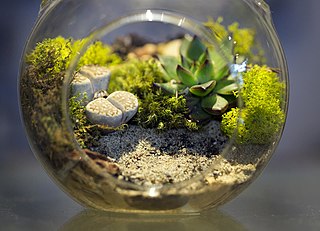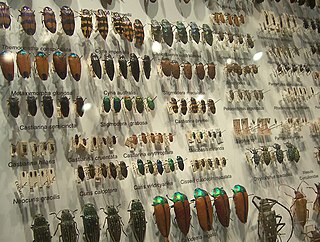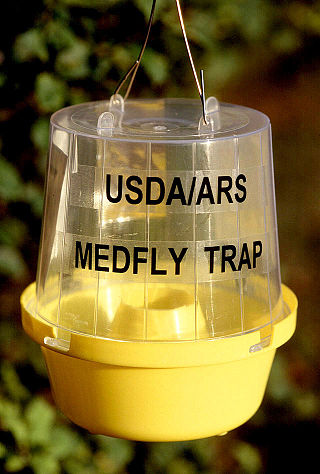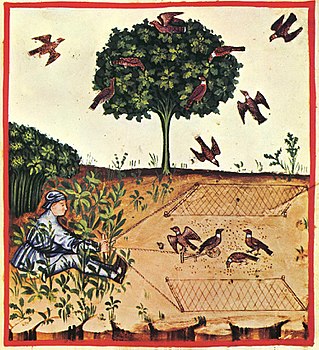
A mousetrap is a specialized type of animal trap designed primarily to catch and, usually, kill mice. Mousetraps are usually set in an indoor location where there is a suspected infestation of rodents. Larger traps are designed to catch other species of animals, such as rats, squirrels, and other small rodents.

A fishing lure is any one of a broad category of artificial angling baits that are inedible replicas designed to mimic prey animals that attract the attention of predatory fish, typically via appearances, flashy colors, bright reflections, movements, vibrations and/or loud noises which appeal to the fish's predation instinct and entice it into gulping the lure. Angling activities using lures are known as lure fishing.

A vivarium is an area, usually enclosed, for keeping and raising animals or plants for observation or research. Water-based vivaria may have open tops providing they are not connected to other water bodies. An animal enclosure is considered a vivarium only if it provides quality of life through naturalistic components such as ample living space and natural decor that allow and encourage natural behaviours. Often, a portion of the ecosystem for a particular species is simulated on a smaller scale, with controls for environmental conditions such as temperature, humidity and light.

Pest control is the regulation or management of a species defined as a pest; such as any animal, plant or fungus that impacts adversely on human activities or environment. The human response depends on the importance of the damage done and will range from tolerance, through deterrence and management, to attempts to completely eradicate the pest. Pest control measures may be performed as part of an integrated pest management strategy.

Insect collecting refers to the collection of insects and other arthropods for scientific study or as a hobby. Most insects are small and the majority cannot be identified without the examination of minute morphological characters, so entomologists often make and maintain insect collections. Very large collections are conserved in natural history museums or universities where they are maintained and studied by specialists. Many college courses require students to form small collections. There are also amateur entomologists and collectors who keep collections.

A solar still distills water with substances dissolved in it by using the heat of the Sun to evaporate water so that it may be cooled and collected, thereby purifying it. They are used in areas where drinking water is unavailable, so that clean water is obtained from dirty water or from plants by exposing them to sunlight.

A lobster trap or lobster pot is a portable trap that traps lobsters or crayfish and is used in lobster fishing. In Scotland, the word creel is used to refer to a device used to catch lobsters and other crustaceans. A lobster trap can hold several lobsters. Lobster traps can be constructed of wire and wood, metal and netting, or rigid plastic. An opening permits the lobster to enter a tunnel of netting or other one-way device. Pots are sometimes constructed in two parts, called the "chamber" or "kitchen", where there is bait, and exits into the "parlor", which prevents escape. Lobster pots are usually dropped to the sea floor, one or more at a time, sometimes up to 40 or more, and are marked by a buoy so they can be picked up later.

A Malaise trap is a large, tent-like structure used for trapping, killing, and preserving flying insects, particularly Hymenoptera and Diptera. The trap is made of a material such as PET (polyester) netting and can be various colours. Insects fly into the tent wall and are funneled into a collecting vessel attached to its highest point. It was invented by René Malaise in 1934.
A fly-killing device is used for pest control of flying insects, such as houseflies, wasps, moths, gnats, and mosquitoes.

Zoophily, or zoogamy, is a form of pollination whereby pollen is transferred by animals, usually by invertebrates but in some cases vertebrates, particularly birds and bats, but also by other animals. Zoophilous species frequently have evolved mechanisms to make themselves more appealing to the particular type of pollinator, e.g. brightly colored or scented flowers, nectar, and appealing shapes and patterns. These plant-animal relationships are often mutually beneficial because of the food source provided in exchange for pollination.

Insect traps are used to monitor or directly reduce populations of insects or other arthropods, by trapping individuals and killing them. They typically use food, visual lures, chemical attractants and pheromones as bait and are installed so that they do not injure other animals or humans or result in residues in foods or feeds. Visual lures use light, bright colors and shapes to attract pests. Chemical attractants or pheromones may attract only a specific sex. Insect traps are sometimes used in pest management programs instead of pesticides but are more often used to look at seasonal and distributional patterns of pest occurrence. This information may then be used in other pest management approaches.
A rat trap is a trap designed to catch rats. Designs are often larger variations on mousetraps.

Animal trapping, or simply trapping or ginning, is the use of a device to remotely catch an animal. Animals may be trapped for a variety of purposes, including food, the fur trade, hunting, pest control, and wildlife management.

A surface lure or topwater lure is a diverse class of fishing lure designed to attract predatory fish through commotions produced at the water surface, imitating preys of interest swimming at the surface such as injured baitfish, frogs, wading mice, lizards and water snakes, drowning insects and dabbling ducklings. These lures are preferred by some anglers due to the belief that they attract larger-than-average fish, and from the added excitement of actually seeing the sudden splashes created by fish aggressively breaching the surface to strike the lure, in some instances even clearly seeing the fish stalking the lure before striking.
Home-stored product entomology is the study of insects which infest foodstuffs stored in the home. It deals with the prevention, detection and eradication of the pests.
Entomological evidence collection is the process of collecting evidence based on insect clues used in criminal investigations. If evidence is not carefully preserved at a crime scene after a death, it may be difficult or impossible for an entomologist to make an accurate identification of specimens, if for example, all morphological characteristics are not preserved.

A pitfall trap is a trapping pit for small animals, such as insects, amphibians and reptiles. Pitfall traps are a sampling technique, mainly used for ecology studies and ecologic pest control. Animals that enter a pitfall trap are unable to escape. This is a form of passive collection, as opposed to active collection where the collector catches each animal. Active collection may be difficult or time-consuming, especially in habitats where it is hard to see the animals such as in thick grass.

A pheromone trap is a type of insect trap that uses pheromones to lure insects. Sex pheromones and aggregating pheromones are the most common types used. A pheromone-impregnated lure, as the red rubber septa in the picture, is encased in a conventional trap such as a bottle trap, Delta trap, water-pan trap, or funnel trap. Pheromone traps are used both to count insect populations by sampling, and to trap pests such as clothes moths to destroy them.

A flight interception trap is a widely used trapping, killing, and preserving system for flying insects. It is especially well-suited for collecting beetles, since these animals usually drop themselves after flying into an object, rather than flying upward. Flight Interception Traps are mainly used to collect flying species which are not likely to be attracted to bait or light.
Integrated pest management in museums, libraries, archives and private collections is the practice of monitoring and managing pest and environmental information with pest control methods to prevent pest damage to collections and cultural property. Preserving cultural property is the ultimate goal for these institutions. The pests come in many different forms: insects, mites, rodents, bats, birds, and fungi and the two most common types are insects and fungi. It is widely recommended that every museum have some form of pest control in place and monitoring system to protect their collection and that museums review their storage and museum facilities to determine how to best control and prevent pest infestations while utilizing an Integrated Pest Management plan.



















